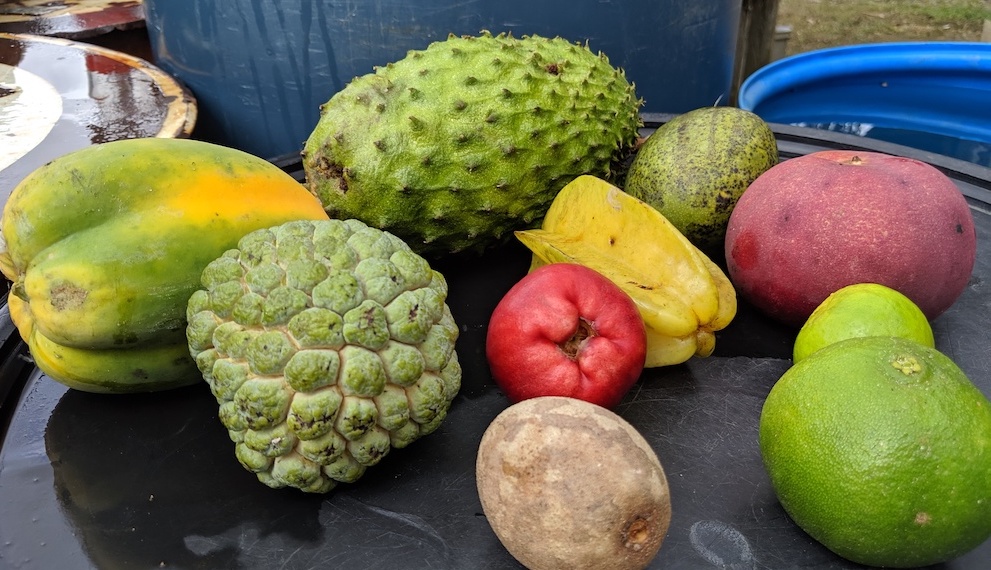Last Thursday, we visited a few farms in remote locations, referred to as “the bush” by the locals. Completely off the grid; using rain-water as their water supply, no need for electricity or using diesel generators when needed, fruits and vegetables everywhere, and the forest is your toilet. There are lots of mosquitoes in the forest… and monkeys… but let’s focus on the crops, not craps.
We went to a few farms all in close proximity. We were accompanied by someone from NAREI (National Agricultural Research & Extension Institute) which plays a similar role to Texas A&M AgriLife in Texas, and he acted as a bit of a guide to show some of the pests and diseases the growers were facing there. For starters, one of the farmers appeared to actually be quite an involved entrepreneur. Her business card states that she also owns a hotel, restaurant, and nightclub, and she has this parcel of land as a side-gig. Alas, her guava alone was 100% infested by a fruit fly species, most likely the guava fruit fly (Bactrocera correcta). The fruit fly lays its eggs in the fruit and the larvae consume the insides; not unlike the spotted wing drosophila problem we have been facing in the continental USA since 2008, which effects pretty much all soft-bodied fruit. Spinosad, a toxin created by the soil bacterium Saccharopolyspora spinosa, is considered an effective insecticide against this pest, however I couldn’t find any registered spinosad products available in Guyana. The next best thing is to go for sanitation; the larvae stay in the fruit and come out as new adults after the fruit has fallen off the tree. The fruit need to be collected regularly, bagged & solarized or buried deep in the ground. This will, over time, greatly reduce the fly populations in their area.



One of the most hard-hit fruit here appears to be the Soursop, which I mentioned in one of my earliest posts. The farms we visited appeared to have consistent bore holes caused by the soursop seed borer; a wasp that uses a long ovipositor (organ used to lay eggs) to lay eggs inside the seeds of the soursop fruit when it’s small. The larvae stay within the fruit and eat the seeds, pupate (similar to a ‘cocoon’ in butterflies) and come out of the fruit as new wasps, creating those bore holes (seen below). The soursop fruit also have a few species of scale insects and mealybugs that also seem to attack it. The species that are on the fruit resemble a species of snow scale, pink hibiscus mealybug, and breadfruit mealybug. It also doesn’t help that there are ants that appear to be tending the scale and/or mealybugs – a common mutualistic relationship between ants and sucking insect pests, where ants where eat the sugary solution excreted from the sucking insect pest and in return, provide them with protection from predators. Since soursop is considered a relatively high-value crop, it may be feasible to bag with plastic or fine mesh around the fruit when small (less than 5 cm in diameter) to prevent the wasp from laying eggs. Once the fruit is larger than that diameter, the wasp’s ovipositor is not long enough to get to the seed – so larger fruit are at a greatly reduced risk. However, before bagging, the fruit need to be cleaned of any scales or mealybugs, with a brush and water/soap solution, otherwise the scale may do very very inside the bag (due to exclusion of predators).






However, when you’re out and about on these farms, it’s not all work and no play. These farmers are incredibly generous and loved to feed us. Starting with some coconuts right off the tree to quench our thirst, we then started eating fruit that I had never heard of before. Sapodilla, rose apple, sugar apple, and ‘peach’ (which is not like our peach at all and I’m having difficulty finding the correct taxonomic name for it!), just to name a few. I also saw Pomelo larger than I have ever seen before! Pomelo is considered one of the original citrus species, which many other species are hybrids of. The textures, flavors, and aromas of these fruit are nothing like I have had before, so it’s hard to give them some context or explain them. All I can say is that they have a great abundance of it and they are incredibly delicious!







An interesting conversation we had this day with NAREI employee was the meaning of “poverty” – whether its just a state of mind. These people in ‘the bush’ have nothing, but have everything! Their dwelling was incredibly simple, no tech or connectivity to the world, very few manufactured material possessions, but they had land rich in food and a beautiful landscape. In one way it made me appreciate the things I do have, but also makes me reflect on what we truly need to be ‘prosperous’.
Below are a few more relevant photos from this day of farm touring, without too much elaboration.













